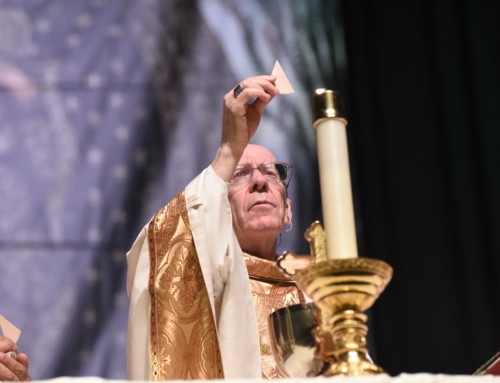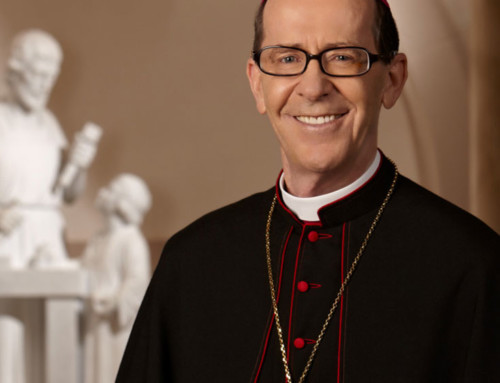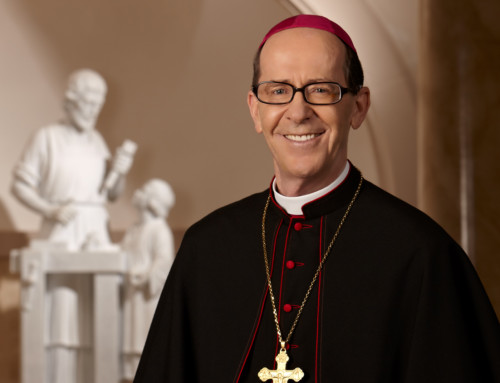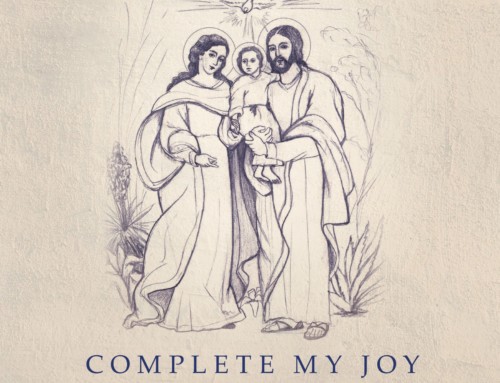Evangelizing through Catholic Schools
Dear Brothers and Sisters in Christ,

The Most Rev. Thomas J. Olmsted, Bishop of the Roman Catholic Diocese of Phoenix.
Catholic schools assist the Church in her mission of evangelization in 5 ways:
- to be a place of encounter with the living Jesus Christ;
- to be places of Spirit-filled community;
- to impart a Catholic worldview through the curriculum;
- to assist students in becoming free; and
- to send students out as missionary disciples to transform the culture.
Let us explore each of these briefly.
A place of encounter
When Andrew and a companion first encountered Jesus, through the witness of John the Baptist, they asked him (Jn 1:35ff), “Rabbi, where are you staying?” His response was, “Come and you will see.” Jesus, the Word made flesh, invited His first disciples to be in a living relationship with Him — to have an encounter with Him. Perhaps there was a time when we could correctly assume that a Catholic has had a meaningful encounter with Jesus Christ if he has received the sacraments of initiation and participates in Mass each Sunday. No longer can we make that assumption.
Catholic schools, thanks be to God, are places of evangelization by assuring that all students have the basic Gospel message proclaimed to them, are confronted with a choice, and then given the freedom and help to make a response in faith. Faith comes from what is heard, thus students cannot respond to the Gospel until they have first heard it. To be sure, many students have first to develop a relationship of trust with a disciple of Christ (what we call pre-evangelization) for the proclamation to be effective. But once that is established through hospitality and kindness, the most loving thing a Catholic school can do is to share with each person the living Jesus Christ. As Pope Benedict XVI told Catholic educators in Washington D.C. (April 17, 2008), “First and foremost every Catholic educational institution is a place to encounter the living God who in Jesus Christ reveals His transforming love and truth.”
A Spirit-filled community
A Catholic school is called to be more than an institution; it is a “genuine community of faith” (Cf. J. Michael Miller, CSB, The Holy See’s Teaching on Catholic Schools). Because Catholic schooling is done on behalf and in the name of parents, our schools seek to reproduce the “warm and intimate atmosphere of family life” (Ibid). St John Bosco said “education is a thing of the heart” and therefore requires the personal accompanying of a teacher (Ibid.).
Jesus Himself taught His disciples in the context of fraternity and friendship. In a world that is often trying to replace authentic friendship with superficial and technological connections, a Catholic school is a Spirit-filled community of young people that affirms their dignity in being made in God’s image and likeness. This community of faith is built through the joint efforts of parents, teachers, administrators and students. How beautiful when our Catholic school communities fulfill Jesus’ words, “This is how all will know that you are my disciples, if you have love for one another” (John 13:35).
Catholic worldview imparted through the curriculum
A constitutive aspect of the Christian faith is a unique way of “seeing” the world. Catholic schools are far more than public schools with religion class and morality added. Rather, the ethos of a Christian education vivifies and unites the totality of the school’s curriculum:
- Science and math classes are taught with a posture of wonder towards the created world, knowing that God has imbued all creation with intelligibility;
- Students are exposed to the best of Western Civilization — its literature, poetry, art, architecture, etc. — as it was taken up and perfected through the act of faith;
- History is seen through the eyes of faith knowing that Jesus is the Lord of History;
- Social and human problems are explored through the lens of Catholic social teaching, recognizing the dignity of the human person, and the principles of subsidiarity and solidarity.
Through inculcation of these, our students receive from a Catholic education a way of seeing the world that is full of beauty, wonder, truth and goodness. This is the antidote to an education that is fragmented, utilitarian and frequently devoid of real beauty. Francis Bacon once quipped, “knowledge is power”; as Catholics, we believe that “knowledge is wonderful.” Our Catholic educational institutions have the joy and responsibility of presenting to students a purposeful world willed into being by the creative love of our Heavenly Father.
Students taught true freedom
Catholic education forms students to have true freedom. As Jesus states, “You will know the truth, and truth will set you free” (John 8:32). Freedom is truly free, only when it is rooted in the truth. True freedom is “freedom for excellence”; hence, freedom increases when something more fully becomes the thing it was created to be. A train is most free when on its tracks because it is doing what it was created to do. A joyful and evangelized person is truly free to be and to live as a child of God.
False notions of freedom arise when they separate freedom from truth, thereby reducing it to mere autonomy. As Jesus states, “Everyone who commits sin is a slave of sin” (John 8:34). In other words, to act against the divine design God has inscribed in all of us is to become less free, to move further away from the purpose for which God created us. Catholic Education considers the fullness of who a person is: namely someone created in God’s image and likeness, destined for eternal life, tainted by original sin and yet redeemed and loved by God so he can fulfill his original destiny. As Pope Pius XI stated (Divini Illius Magistri, #7), “There can be no true education which is not wholly directed to man’s last end.”
All education seeks to better man, but that begs the question, “what is man?” Why is he here and what is he for? The Gospel of Jesus Christ answers these questions; thus, when Catholic education imparts to students the intellectual and moral virtues to know the Truth and to love the Good (which are both ultimately found in God) it is giving students the gift of true freedom. A joyful and evangelized person is a person who is truly free to be and to live as a child of God.
Forming Missionary Disciples
Ships are made in the harbor, but they were not made to stay there. The Church is missionary by her nature. Jesus was sent by the Father into the world in the power of the Holy Spirit. He, in turn, sends out His disciples to teach all nations (Mt 28:18ff). Our Catholic schools, therefore, cannot exist for themselves. After students have encountered the risen Christ, and been formed into communities of faith and freedom, the Gospel demands they be sent into the world as ambassadors of the truth and love of Christ.
A mark of a truly Catholic school is the fruit that is borne in the lives of its graduates. That fruit is to be shown in the missionary activity of its graduates, called and sent by Jesus to be salt and light in the culture around them, knowing that people and cultures die without Christ. As Pope Paul VI stated (Evangelii Nuntiandi, #24), It is “unthinkable that a person should accept the Word and give himself to the kingdom without becoming a person who bears witness to it and proclaims it in his turn.”
Conclusion
What a noble vocation it is to be a Catholic educator, to assist young people in discovering who they are and for what they are made. St. Catherine of Siena once remarked, “Be who God meant you to be and you will set the world on fire.” When Catholic Education is what it is called to be, it too has the power to set the world on fire. May the parents, teachers and school children of our local Catholic schools — through their constant contact with Jesus the Word made Flesh — be inspired missionary disciples of His Kingdom.
St. Katharine Drexel, pray for us.
Our Lady of Guadalupe, pray for us.
Sincerely yours in Christ,
+Thomas J. Olmsted
Bishop of Phoenix
Promulgated on the Feast of St. Katharine Drexel, March 3, 2017.






